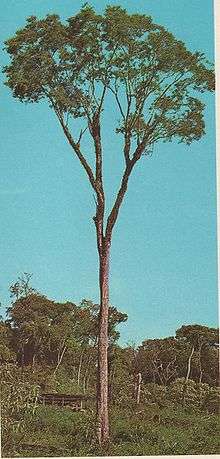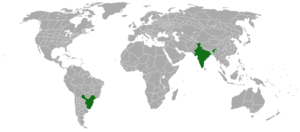Parapiptadenia rigida
| Parapiptadenia rigida | |
|---|---|
 | |
| Scientific classification | |
| Kingdom: | Plantae |
| (unranked): | Angiosperms |
| (unranked): | Eudicots |
| (unranked): | Rosids |
| Order: | Fabales |
| Family: | Fabaceae |
| Subfamily: | Mimosoideae |
| Genus: | Parapiptadenia |
| Species: | P. rigida |
| Binomial name | |
| Parapiptadenia rigida (Benth.)Brenan | |
 | |
| Range of Parapiptadenia rigida | |
| Synonyms | |
Parapiptadenia rigida is a perennial shrub or tree. It is not a threatened species. It is native to Argentina, Brazil, Paraguay and Uruguay. Common names include Angico, Angico-cedro, Angico-do-banhado, Angico-dos-montes, Angico-verdadeiro, Angico-vermelho, Guarucaia and Paric.[1]
Parapiptadenia rigida grows from about 18m to 30m in height and it has a straight trunk which has slightly furrowed bark. The foliage is dark green and the flowers are greenish-yellow 5 cm to 9 cm long. It blooms in the Spring. The seed pods grow 9 cm to 16 cm in length. The seeds are flat, oval and brown. It is found along the lengths of rivers.
Uses
Essential oils
"Essential oils" from the tree are becoming more widely recognized in industrial fragrance production.[2]
Gum
Gum from the tree can be used in the same way as gum arabic.[3]
Traditional uses
Extracts from the tree have astringent, expectorant, anti-diarrheal, and hemmorage-arresting properties.[4] It is used for its antiseptic properties in southern Brazil.[5] The bark has a high tannin content of 15.0%[6] and it is used in folk medicine as a bitter-tasting tonic and body cleanser. It is used to treat rickets, lack of appetite and muscle weakness.[7] Parapiptadenia rigida is psychoactive.[8]
Tannin
The tree's bark contains 15.0% tannin.[9]
Wood
Its dense, wood is resistant to the elements and is used for construction,[10] carpentry, beams for bridges,[7] poles and firewood.[11] The wood is said to be unaffected by insects including termites and it can last more than 20 years unpainted.
Mechanical properties
It has a "Janka Hardness" of 2300-3700 lb.,[12] a parallel "bending strength" of 16900 psi, a parallel "compression strength" of 8500 psi and a density of 720–1199 kg/m³[13][14] at a moisture content of 12-15%. Its modulus of elasticity is 157 801 kg/cm².[15]
For hardwood flooring it is called "Pepperwood."[12]
References
- 1 2 International Legume Database & Information Service (ILDIS)
- ↑ Perfumer and Flavorist Magazine
- ↑ Anadenanthera: Visionary Plant of Ancient South America By Constantino Manuel Torres, David B. Repke, p. 98
- ↑ PDF Múltiplos Usos de Espécies Vegetais Pela Farmacologia Guarani Através De Iinformações Històricas
- ↑ Bionews Online
- ↑ Google Books Anadenanthera: Visionary Plant of Ancient South America By Constantino Manuel Torres, David B. Repke p. 96
- 1 2 Árvoresdeirati
- ↑ Index of Rätsch, Christian. Enzyklopädie der psychoaktiven Pflanzen, Botanik, Ethnopharmakologie und Anwendungen, 7. Auflage. AT Verlag, 2004, 941 Seiten. ISBN 3-85502-570-3 at
- ↑ Anadenanthera: Visionary Plant of Ancient South America By Constantino Manuel Torres, David B. Repke
- ↑ Florestar Estatístico
- ↑ Bericht ueber die Exkursion des Lehrstuhls fuer Vegetationsoekologie durch Suedamerika 2005
- 1 2 J.G. Architectural
- ↑ Argentinean Hard Woods
- ↑ World AgroForestry
- ↑ Ficha Técnica: Anchico Colorado (Spanish)